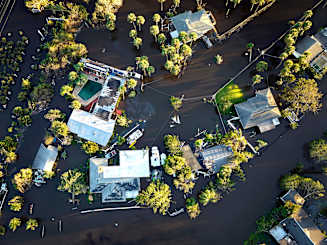60%
In 2024, global economic losses amounted to $368 billion. Sixty percent of these losses were not covered by insurance.
Source: Aon’s 2025 Climate and Catastrophe Insights report

In the face of escalating climate-related challenges, businesses are proactively utilizing sophisticated data analytics and advanced climate models to minimize risks and mitigate potential impact. By harnessing these tools, organizations are developing robust strategies to protect their assets and ensure operational continuity, thereby unlocking new opportunities in an ever-changing environment.
In 2024, the world endured $368 billion in global economic losses,1 of which only 40 percent was insured. This significantly compromises the ability for communities to rebuild and adapt for the future climate. This is known as the “protection gap” and it must be closed.
Changing climate conditions are demanding organizations address evolving risks and prepare for the journey to net zero in some of the following ways:
In 2024, global economic losses amounted to $368 billion. Sixty percent of these losses were not covered by insurance.
Source: Aon’s 2025 Climate and Catastrophe Insights report
Natural catastrophe and climate modeling are helping organizations understand and assess their most significant exposures. The identification and quantification of risk available through these tools also enable efforts to mitigate the impact of climate risk through alternative risk transfer solutions, such as parametric insurance, which are available in areas where traditional risk transfer solutions may not.
Robust climate modeling must consider a company's unique footprint, down to the asset level, and have global coverage.
“We have truly global data sets for chronic and acute risks — freeze risk, extreme precipitation, inland and coastal flood (including sea level rise), extreme heat, tropical cyclone and drought — and can provide a view of how these hazards will evolve over time,” explains Liz Henderson, global head of Climate Risk Advisory. “It is not a catastrophe or a full loss model, but it does give you an initial view regarding likely changes in climate risk and potential impacts on your business operations.”
Chronic perils are driven by slowly evolving changes in temperature and rainfall patterns such as heatwaves, drought and rising sea levels. The physical risk and impacts accumulate over a long period of time and are the result of sustained or frequent exposure to increased hazard.
Acute perils, on the other hand, are infrequent, short-acting events like severe convective storms, hurricanes and floods — perils traditionally analyzed and covered by the insurance industry. The large impacts that these types of events can have on the insurance industry have led to the development of catastrophe models that can measure and manage their impacts. These models have traditionally been more focused on near-term risk. However, the increasing losses and volatility we are observing is resulting in the need for a more forward-looking view.
Risk from chronic perils in the future can be projected using standard climate modeling approaches, while changes in acute perils are more challenging to project.
Some modeling firms are combining both climate and catastrophe modeling approaches by incorporating the impacts of climate into their catastrophe models. For example, Aon’s Impact Forecasting team takes this approach for their U.S. hurricane and Germany flood models to enable longer-term planning around risk management, underwriting and regulatory reporting. By incorporating both chronic and acute risks, Aon's climate modeling provides a comprehensive view of potential changes in climate risk, enabling organizations to be better prepared.

2024 Client Trends Report
The unpredictability of weather and climate can also impact specific sectors, such as renewable energy and infrastructure. Renewable energy projects, like offshore wind farms, need specialist technology to respond to changing climate conditions. As Guido Benz, CEO of Aon’s Global Renewable Energy Practice, explains: “There is a category called hurricane class wind turbines, and they're being certified based on models, but we have not actually seen them withstand the tests. These are elements that come into play in the context of extreme weather in the future.” It is apparent that there is unpredictability in new risks alongside the science and rigor of models.
Insurance has an important role to play in closing the protection gap and encouraging more green technology and innovation — which will ultimately accelerate the journey to net zero. Extreme weather is increasing in frequency and severity, and this threatens insurability and market stability. The economic and financial implications of extreme weather will persist, regardless of any shifts in geopolitical sentiment or regulatory frameworks worldwide. As reinsurance premiums rise and carriers limit coverage for regions deemed too high-risk, there will be an increased emphasis on integrating insurance considerations at the inception of transition projects as part of the capital allocation decision-making process.
Weather and climate risk will likely increase premiums, encourage more public intervention, and ultimately influence where people choose to live and where businesses build new projects. These dynamics will inevitably demand greater public-private partnership to address risk coverage, financing and intellectual property sharing to limit exposures and build climate resilience. This collaboration is increasingly important as we face unpredictable climate patterns and their impacts on various sectors. Recognizing the economic and financial benefits of addressing climate risk through insurance, many countries are implementing local and national reinsurance schemes to fill gaps in coverage in high-risk areas, ultimately leading to more resilient communities.

The International Federation of Red Cross and Red Crescent Societies Disaster Relief Fund (IFRC-DREF) provides immediate funding for National Red Cross and Red Crescent Societies during disasters, especially smaller-scale emergencies. However, high demand often depletes the fund before year-end, prompting the need for a sustainable solution. In 2023, the IFRC collaborated with Aon and reinsurers to secure an indemnity insurance policy, a first in the humanitarian sector, to provide a financial safety net. By September 2024, the fund's demands triggered the policy's first insurance payout, enabling continued support with up to 15 million Swiss francs.
The global regulatory landscape for climate risk is complex, particularly for multinational companies.
“This is a bit of a balancing act for companies in the U.S., where climate and sustainability are political terms, but they have large stakeholders in other regions where enhanced reporting, transparency and action on climate is expected,” explains Laura Wanlass, head of Corporate Governance in Aon’s Talent Solutions practice.
Multinationals need to strike a balance between disclosure and the desire to avoid undue controversy — whether it be accusations of greenwashing or questions from anti-environmental, social and governance (ESG) activists who remain vocal in the U.S.
As part of the transition to a net-zero economy, investors recognize their role in moving the needle toward decarbonization. By providing capital to emerging technologies and greener operating models, they can support the transition process, while also accessing potentially attractive future returns.
| Regulation | What it Requires | |
|---|---|---|
| International Sustainability Standards Board (ISSB) S1 and S2 | The ISSB issued its first two IRFS Sustainability Disclosure Standards in June 2023, with reporting on FY2024 to begin in 2025. IFRS S1 sets out general requirements for a company to disclose information about its sustainability-related risks and opportunities. IFRS S2 sets out requirements for a company to disclose information about its climate-related risks and opportunities (IFRS S2 integrates the recommendations of the Task Force on Climate-related Financial Disclosures (TCFD). | |
| U.S. California State Climate Bills – SB 253 & 261 | SB 253 requires companies with more than $1 billion in revenue that do business in California to report Scopes 1 and 2 greenhouse gas emissions annually beginning in 2026 for the 2025 fiscal year, and Scope 3 GHG emissions beginning in 2027 for the 2026 fiscal year. SB 261 requires companies with more than $500 million in revenue that do business in California to report on climate-related financial risks and measures to address those risks starting in 2026. | |
| U.S. Federal Supplier Climate Risks and Resilience Rule | The proposed rule would require all federal suppliers with over $7.5 million in revenue to report Scope 1 and 2 emissions; suppliers with over $50 million will also be required to disclose Scope 3 emissions, climate-related financial risks and set emissions reduction targets. | |
| European Union Corporate Sustainability Reporting Directive (CSRD) | The EU’s CSRD aims to address shortcomings on transparency and disclosure of non-financial information. The directive requires companies to report on sustainability issues, including ESG factors like greenhouse gas emissions, resource efficiency, human rights, employee diversity and gender pay gap. Additionally, the CSRD mandates disclosure of the impact of their activities on society and the environment. The first companies subject to the CSRD applied the new rules for the 2024 financial year, with reports published in 2025. | |
| Task Force on Climate-Related Financial Disclosures (TCFD) | The TCFD began as voluntary recommendations for companies to make their climate disclosures consistent and comparable. The guidelines have been adopted in many jurisdictions, including the European Union, the United Kingdom, Singapore, Canada, Japan and South Africa. |
Weather and climate are playing an increasingly significant role in workforce strategy, with employers considering multiple factors including:
One of the more pressing considerations is how weather can impact business continuity. Flooding, hurricanes, tornadoes and wildfires can affect a company’s employees, which can then exacerbate impacts on underlying business operations. Mitigation efforts include calculating the number of employees at a given location when doing physical risk modeling and looking for creative risk mitigation strategies — for example, issuing employee resiliency bonds to help employees with costs associated with extreme weather events.
With more employees working in hybrid or remote settings, employers should ensure they have data on where employees are living and when they are commuting. This information can then be paired with physical risk modeling to provide a more complete picture of the true impact of a weather event on the workforce.
In 2024, climate events resulted in approximately 18,100 fatalities.
Source: Aon’s 2025 Climate and Catastrophe Insights report
There are three opportunities businesses need to consider in order to adapt to and mitigate the impact of changing weather and climate.

Natural catastrophe and climate analytics can help companies shape decision making around the issue of weather and climate risk, enabling them to develop strategies to close the protection gap, understand regulatory changes and unlock new sources of risk capital. Bringing together a holistic risk toolkit will help clients examine their property portfolios in detail to determine which risks should be retained or transferred, as well as where to invest in adaptation to reduce risk. This will help drive down the cost of risk by optimizing the value of insurance in their programs.
Parametric coverages, catastrophe bonds and international emissions trading are also useful solutions, all of which are underpinned by climate analytics. These help companies understand future weather impacts and their organization’s unique risk profile.
Ensuring a better understanding of climate projections linked to local hazard risk and impacts on biodiversity are some of the ways companies are looking to mitigate climate exposures. To approach mitigation efforts more holistically, organizations should consider how both a transition to net zero and changes in local biodiversity can impact their business and supply chains. Taking a data-driven approach to achieve this can help clients understand a broad spectrum of risks linked to climate and biodiversity, including temperature, water, land, pressures on flora and fauna, indigenous populations, socioeconomic factors, and future frequency and severity of climate events.
As chronic perils become more deadly, employers know they must respond proactively to protect employees’ health and safety. Meteorological events like heatwaves and droughts impact over 2 billion people worldwide, placing immense pressure on healthcare systems. This results in increased hospital admissions and longer patient stays during the summer months, a trend expected to worsen as temperatures continue to rise. The connection between heat and rising mortality rates, as well as mental health issues such as suicide among vulnerable populations, is well-documented. Vulnerability to heat emergencies is further exacerbated by inequities related to gender, ethnicity and low-income status, with significant regional differences.3
Organizations need to develop strategies to ensure employees and their families have access to health and benefit coverage that protects them from climate-related impacts and illnesses. Temperature-related offerings range from financing for heating and cooling systems to the energy costs themselves.

2024 Client Trends Report
Heatwave-related illnesses can also be acute, so the availability of immediate medical care is critical. Organizations should establish a monitoring program for the early detection of heat-related illness and, through data and analytics, identify vulnerable employees based on factors like pre-existing conditions and location. They can then take proactive measures to ensure their people are protected.
The impact of climate change will require a new approach to risk management; one that considers a broad range of exposures and potential outcomes. Achieving global net zero by 2050 will require an average annual investment of $5.6 trillion from 2025 to 2030.4 The insurance industry will help to create greater certainty around exposure management, unlock investment in green technologies through risk transfer solutions and help businesses build greater resilience in the face of rising weather and climate-related threats. Volatility and complexity will be a feature of climate risk in the coming years, and data-led decision making will be central to building a resilient business and workforce as climate losses and impacts deepen.
Over a 45-year period in Switzerland, hospital admissions for mental disorders increased by 4 percent for every 10°C rise in daily temperature.
Source: PubMed
Aon's Capabilities:
Aon’s Climate Risk Advisory Team helps clients make better decisions on their climate-related financial risks, access capital and unlock growth. By leveraging advanced analytics and modeling both physical and transition risks, Aon provides tailored consulting services and practical solutions to create sustainable and resilient organizations that will stand the test of time.
Through advanced modeling, climate risk consulting helps organizations understand their exposure to climate risk and how to mitigate that risk. Climate risk is a highly interconnected financial risk that can cause business interruptions, material scarcity, supply chain issues, reputational damage, property damage, asset value volatility and more. Aon helps clients make informed decisions around climate risk reduction and embed climate considerations into their strategies.
Alternative Risk Transfer Solutions (ART) play an increasingly important role in corporate risk strategies and can offer creative ways to address risk finance and risk transfer challenges. These solutions include captive insurance, multi-year/multi-line, as well as structured solutions and parametric insurance. They can provide access to additional sources of risk capital beyond traditional forms of risk transfer, including access to capital markets through instruments such as cat bonds and insurance-linked securities.
In terms of climate related risks, the most commonly applied ART solution is probably parametric insurance.
Parametric insurance is complementary to traditional insurance solutions. It can be used in a variety of weather-related situations — extreme heat, windstorms, flooding and wildfires — where a risk must be mitigated but may not be covered via traditional markets.
Aon helps organizations manage their catastrophe exposures with a proven methodology to understand each unique business need. Combined with an unparalleled depth of expertise, Aon’s insights allow clients to manage near-term volatility, build resilience and make better decisions for the future.
In an increasingly risky world, insurers and reinsurers need more sophisticated tools to quantify and manage the risks facing their businesses. Aon’s catastrophe model developers, Impact Forecasting, enable firms to analyze the financial impacts of catastrophic events to develop effective reinsurance, underwriting and exposure management. Impact Forecasting partners with academic and industry organizations to incorporate the latest research into all of Aon’s catastrophe models, enabling firms to analyze the financial impacts of catastrophic events both today and into the future.
Insurers are at the heart of creating a more resilient world, but face many interconnected, emerging risks and growing competition. Now more than ever, insurers require holistic services and global insight to better understand and address their strategic, multi-faceted business needs across growth, capital, operational efficiency and talent.
Embedded in the insurance industry, Aon knows how to listen better and interpret clients’ needs. Our solutions for insurers help them to:
1 2025 Climate and Catastrophe Insights report, Aon
2 2025 Climate and Catastrophe Insights report, Aon
3 Health System Resilience for Extreme Weather Emergencies, Worldwide Universities Network
4 New Energy Outlook 2024, BloombergNEF, Bloomberg Finance LP
General Disclaimer
This document is not intended to address any specific situation or to provide legal, regulatory, financial, or other advice. While care has been taken in the production of this document, Aon does not warrant, represent or guarantee the accuracy, adequacy, completeness or fitness for any purpose of the document or any part of it and can accept no liability for any loss incurred in any way by any person who may rely on it. Any recipient shall be responsible for the use to which it puts this document. This document has been compiled using information available to us up to its date of publication and is subject to any qualifications made in the document.
Terms of Use
The contents herein may not be reproduced, reused, reprinted or redistributed without the expressed written consent of Aon, unless otherwise authorized by Aon. To use information contained herein, please write to our team.
Our Better Being podcast series, hosted by Aon Chief Wellbeing Officer Rachel Fellowes, explores wellbeing strategies and resilience. This season we cover human sustainability, kindness in the workplace, how to measure wellbeing, managing grief and more.
Expert Views on Today's Risk Capital and Human Capital Issues
Expert Views on Today's Risk Capital and Human Capital Issues
Expert Views on Today's Risk Capital and Human Capital Issues
The construction industry is under pressure from interconnected risks and notable macroeconomic developments. Learn how your organization can benefit from construction insurance and risk management.
Stay in the loop on today's most pressing cyber security matters.
Our Cyber Resilience collection gives you access to Aon’s latest insights on the evolving landscape of cyber threats and risk mitigation measures. Reach out to our experts to discuss how to make the right decisions to strengthen your organization’s cyber resilience.
Our Employee Wellbeing collection gives you access to the latest insights from Aon's human capital team. You can also reach out to the team at any time for assistance with your employee wellbeing needs.
Explore Aon's latest environmental social and governance (ESG) insights.
Our Global Insurance Market Insights highlight insurance market trends across pricing, capacity, underwriting, limits, deductibles and coverages.
How do the top risks on business leaders’ minds differ by region and how can these risks be mitigated? Explore the regional results to learn more.
Our Human Capital Analytics collection gives you access to the latest insights from Aon's human capital team. Contact us to learn how Aon’s analytics capabilities helps organizations make better workforce decisions.
Explore our hand-picked insights for human resources professionals.
Our Workforce Collection provides access to the latest insights from Aon’s Human Capital team on topics ranging from health and benefits, retirement and talent practices. You can reach out to our team at any time to learn how we can help address emerging workforce challenges.
Our Mergers and Acquisitions (M&A) collection gives you access to the latest insights from Aon's thought leaders to help dealmakers make better decisions. Explore our latest insights and reach out to the team at any time for assistance with transaction challenges and opportunities.
How do businesses navigate their way through new forms of volatility and make decisions that protect and grow their organizations?
Our Parametric Insurance Collection provides ways your organization can benefit from this simple, straightforward and fast-paying risk transfer solution. Reach out to learn how we can help you make better decisions to manage your catastrophe exposures and near-term volatility.
Our Pay Transparency and Equity collection gives you access to the latest insights from Aon's human capital team on topics ranging from pay equity to diversity, equity and inclusion. Contact us to learn how we can help your organization address these issues.
Forecasters are predicting an extremely active 2024 Atlantic hurricane season. Take measures to build resilience to mitigate risk for hurricane-prone properties.
Our Technology Collection provides access to the latest insights from Aon's thought leaders on navigating the evolving risks and opportunities of technology. Reach out to the team to learn how we can help you use technology to make better decisions for the future.
Trade, technology, weather and workforce stability are the central forces in today’s risk landscape.
Our Trade Collection gives you access to the latest insights from Aon's thought leaders on navigating the evolving risks and opportunities for international business. Reach out to our team to understand how to make better decisions around macro trends and why they matter to businesses.
With a changing climate, organizations in all sectors will need to protect their people and physical assets, reduce their carbon footprint, and invest in new solutions to thrive. Our Weather Collection provides you with critical insights to be prepared.
Our Workforce Resilience collection gives you access to the latest insights from Aon's Human Capital team. You can reach out to the team at any time for questions about how we can assess gaps and help build a more resilience workforce.